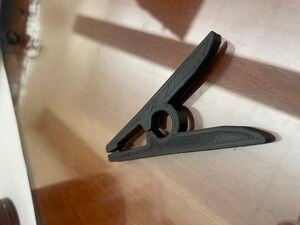
Author & Creator[edit | edit source]
Project developed by Brad Mulwenge
Abstract[edit | edit source]
This is a 3D-printed clip/peg designed to provide an easy and affordable solution for organizing and securing various items in the home. The clip is designed with a strong grip and durable material, allowing it to securely hold onto surfaces such as clothing, bags, and other items.
The design is created using OpenSCAD, an open-source software for creating 3D models, and is an accessible and customizable solution. The clip can be easily adapted to fit different sizes and shapes, making it a versatile solution for a range of household needs.
This OSAT project is appropriate because it fulfills the basic need for organization and helps to reduce waste by providing a reusable solution. It is a low-cost solution that can be produced using open-source 3D printing technology, making it accessible to a wide range of users.
Overall, this 3D printed clip/peg is an improvement on existing designs, incorporating feedback from users and addressing common issues such as weak grip and low durability. Its simple and practical design makes it a valuable asset for anyone looking for an affordable and efficient solution for organizing and securing items in the home.
Bill of Materials[edit | edit source]
- Provide a full BOM -- Materials needed for fabrication of device and alternative materials if they are not available, prices/sources of non-printable parts
Tools needed[edit | edit source]
- Jellybox or similar RepRap 3-D printer
- Any filament of your choice.
Skills and knowledge needed[edit | edit source]
- To create this 3D printed clip/peg project, you will need basic knowledge of 3D printing and access to a 3D printer. If you are new to 3D printing, you may find these resources helpful:
Technical Specifications and Assembly Instructions[edit | edit source]
- To print the clip/peg, you will need to download the 3D model file and upload it to your 3D printer software. The file is available for free download from Clip STL File. The print time estimate is approximately 30 minutes, depending on your printer's settings and speed. The clip is ready to use after Printing is done.
Common Problems and Solutions[edit | edit source]
- One common issue with 3D printing is that the printed part may not turn out as expected due to printer calibration or other factors. To avoid this, make sure your printer is properly calibrated and use the recommended settings for printing the clip/peg. Another issue that may arise is the clip/peg not fitting properly or being too loose. If this happens, try adjusting the printer's settings or printing a new clip/peg with a tighter fit.
Cost savings[edit | edit source]
- This 3D printed clip/peg project is a low-cost solution for organizing and securing various items in the home. The estimated cost of materials is approximately $0.25 per clip/peg, assuming a cost of $20 per kilogram of filament.
Benefited Internet Communities[edit | edit source]
References[edit | edit source]
- The sources of information (e.g. engineering handbooks, journal articles, government documents, webpages, books, magazine articles etc.). References should use the and <references /> tags and can be in any format but should include all the information necessary for someone else to find the same information you did. For example:[1]
Based on the developmental needs addressed (e.g. food, heat, electricity, clean water, health care, etc.) be sure to label your device in the proper categories e.g. use . Be sure to categorize your device so that it will be easy to find – for example "Low voltage connection basics" is categorized in